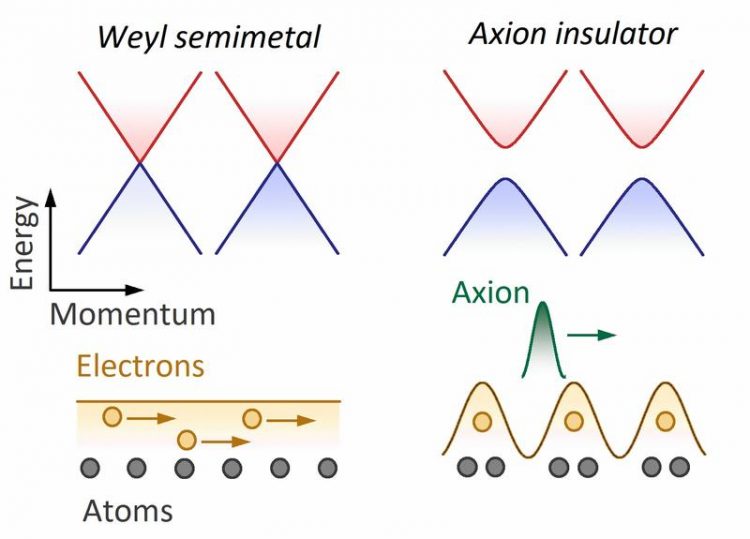Axion particle spotted in solid-state crystal

Scheme of a Weyl-semimetal-based axion insulator Johannes Gooth, MPI CPfS
The team found signatures of axion particles composed of Weyl-type electrons (Weyl fermions) in the correlated Weyl semimetal (TaSe₄)₂I. At room temperature, (TaSe₄)₂I is a one-dimensional crystal, in which electrical current is conducted by Weyl fermions. However, by cooling (TaSe₄)₂I down below -11 °C, these Weyl fermions themselves condense into a crystal – a so called “charge density wave” – which distorts the underlying crystal lattice of the atoms.
The initially free Weyl fermions are now localized and the initial Weyl semimetal (TaSe₄)₂I becomes an axion insulator. Similar to the existence of free electrons in metallic atomic crystals, the Weyl semimetal-based charge-density-wave crystal hosts axions that can conduct electrical current.
However, such axions behave quite differently from the more familiar electrons. When exposed to parallel electric and magnetic fields, they produce an anomalous positive contribution to the magnetoelectric conductivity.
Based on predictions from Andrei Bernevig's group at Princeton University, the group of Claudia Felser in Dresden produced the charge density wave Weyl metalloid (TaSe₄)₂I and investigated the electrical conduction in this material under the influence of electric and magnetic fields. It was found that the electric current in this material below -11 °C is actually carried by axion particles.
The results of the experiments were published in Nature magazine.
“It's very surprising that materials that we think we know are suddenly showing such interesting quantum particles,” says Claudia Felser, one of the lead authors of the paper.
Examining the novel properties of axion particles in table-top experiments could not only allow scientists to better understand the mysterious realm of quantum particles, but also to open up the field of highly correlated topological materials.
“Another building block to my lifelong dream of realizing ideas from astronomic and high-energy physics with table-top experiments in solids,” says Johannes Gooth.
The research at the Max Planck Institute for Chemical Physics of Solids (MPI CPfS) in Dresden aims to discover and understand new materials with unusual properties.
In close cooperation, chemists and physicists (including chemists working on synthesis, experimentalists and theoreticians) use the most modern tools and methods to examine how the chemical composition and arrangement of atoms, as well as external forces, affect the magnetic, electronic and chemical properties of the compounds.
New quantum materials, physical phenomena and materials for energy conversion are the result of this interdisciplinary collaboration.
The MPI CPfS ( www.cpfs.mpg.de ) is part of the Max Planck Society and was founded in 1995 in Dresden. It consists of around 280 employees, of which about 180 are scientists, including 70 doctoral students.
Johannes Gooth
johannes.gooth@cpfs.mpg.de
Gooth, J. et al. Axionic charge-density wave in the Weyl semimetal (TaSe4)2I. Nature https://doi.org/10.1038/s41586-019-1630-4 (2019).
https://www.nature.com/articles/s41586-019-1630-4
https://doi.org/10.1038/s41586-019-1630-4
https://www.cpfs.mpg.de/3126101/20191007_04
Media Contact
All latest news from the category: Physics and Astronomy
This area deals with the fundamental laws and building blocks of nature and how they interact, the properties and the behavior of matter, and research into space and time and their structures.
innovations-report provides in-depth reports and articles on subjects such as astrophysics, laser technologies, nuclear, quantum, particle and solid-state physics, nanotechnologies, planetary research and findings (Mars, Venus) and developments related to the Hubble Telescope.
Newest articles

NASA: Mystery of life’s handedness deepens
The mystery of why life uses molecules with specific orientations has deepened with a NASA-funded discovery that RNA — a key molecule thought to have potentially held the instructions for…

What are the effects of historic lithium mining on water quality?
Study reveals low levels of common contaminants but high levels of other elements in waters associated with an abandoned lithium mine. Lithium ore and mining waste from a historic lithium…

Quantum-inspired design boosts efficiency of heat-to-electricity conversion
Rice engineers take unconventional route to improving thermophotovoltaic systems. Researchers at Rice University have found a new way to improve a key element of thermophotovoltaic (TPV) systems, which convert heat…



